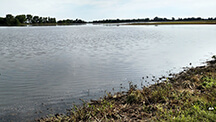Indiana grain yields to be better than expected
October 15, 2015
 |
|
This farm field in Indiana last spring turned into what looks like a lake from frequent rain. Although many plants were destroyed, the state's corn and soybean crops overall recovered to the point where losses are much less than what had been feared at the time, and normal yields are now expected. (Purdue Agricultural Communication photo/Steve Cain) |
WEST LAFAYETTE, Ind. - Indiana's soybean crop has apparently recovered enough to produce near-normal statewide yields following this year's record rains and flooding, and the corn crop appears to be healthier than expected in some parts of the state, Purdue Extension economist Chris Hurt says.
"In the summer I estimated that the flooding losses of Indiana corn and soybeans could reach $500 million," Hurt said. "The actual losses now appear to be much smaller - around $200 million and concentrated in certain areas."
According to the latest U.S. Department of Agricultural estimates, statewide soybean yields will be 51 bushels per acre, higher than the 50 bushels per acre expected in "normal" weather conditions, Hurt said. Over the previous three years, the state's soybean yield has averaged 50.5 bushels per acre, including last year's record 56 bushels per acre and 44 bushels per acre in the drought year of 2012.
The soybean crop is expected to be especially strong in the southern part of the state, which was spared the worst of the severe weather in June and July, with the USDA projecting yields of 5-10 percent above normal there.
"In many areas soybean yields were able to recover in August and September," Hurt said. "However, several areas will still see yields 5-10 percent below normal. These include the northeast, northwest and east-central regions of the state."
Hurt said the condition of the corn crop varied by region, with USDA estimates for the entire state at 156 bushels per acre, about 10 bushels below a normal yield. Over the past three years, the statewide corn yield has averaged 154 bushels per acre, including last year's record 188 bushels per acre and 99 bushels per acre during the drought year of 2012.
"Flooding damage on corn was more permanent in the northern two-thirds of the state where USDA yield estimates by crop reporting district are down 5-20 percent from normal," Hurt said. "The worst-hit areas are the northwest and west-central parts of the state."
Like soybeans, the corn crop is healthier in the southern part of the state.
"Southern Indiana has corn yields that are 5-10 percent greater than a normal weather year," Hurt said.
Hurt stressed that while the overall picture looks brighter than first thought, many individual farm families throughout the state have sustained major losses.
"These farms may have elected crop insurance, which may help their financial situation somewhat, and low yield areas are more likely to receive higher government payments."
In addition, he said, disaster loans might be available for farmers in some counties.
"However, Indiana farm income will still be depressed for all areas and even weaker in low-yield areas," he said.
Writer: Darrin Pack, 765-494-8415, dpack@purdue.edu
Sources: Chris Hurt, 765-494-4273, hurtc@purdue.edu
Ag Communications: (765) 494-2722;
Keith Robinson, robins89@purdue.edu
Agriculture News Page

